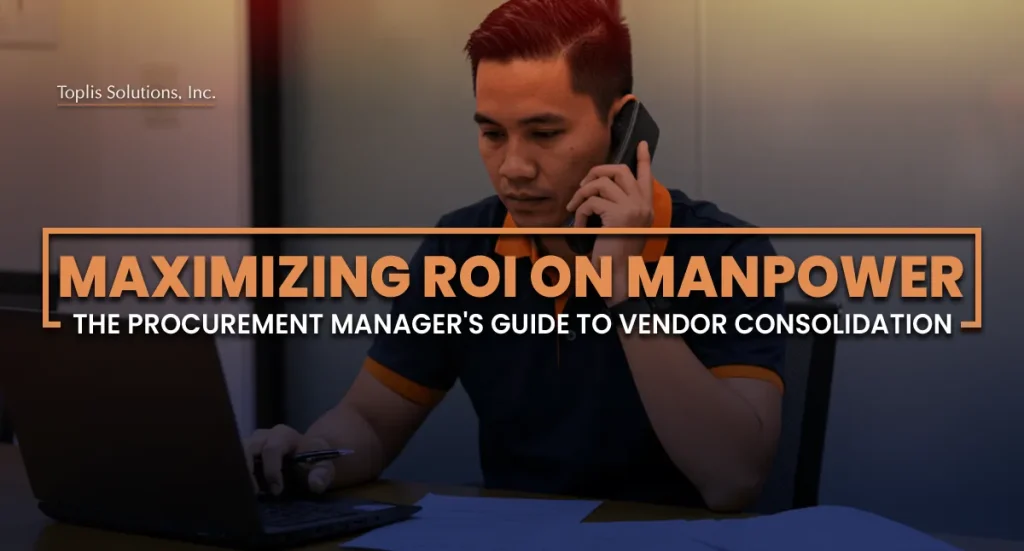Procurement managers often work with many vendors. But as the business grows and manpower needs change, managing too many suppliers can cause confusion, increase costs, and reduce control over operations
If you’re a Procurement Manager dealing with high labor costs or poor service quality, it may be time to review your vendor consolidation strategy.
A smart vendor consolidation strategy can boost your manpower ROI. By working with fewer, more reliable suppliers, your procurement team can cut costs, reduce complexity, and improve workforce efficiency.
Fewer vendors make it easier to manage operations, maintain consistent service, and achieve better long-term results.
In this blog, you’ll discover the benefits of consolidating manpower vendors, easy steps to do it right, and how to track improvements in your manpower ROI.
Table of Contents
What is a Vendor Consolidation Strategy?
- Definition and Core Concept
- What are the benefits of Vendor Consolidation?
How Vendor Consolidation Impacts Manpower ROI
- The Hidden Cost of Managing Too Many Suppliers
- Key ROI Gains from Vendor Consolidation
Challenges and Solutions of Vendor Consolidation
Steps to Create an Effective Procurement Vendor Consolidation Strategy
What is Vendor Consolidation Strategy?
Definition and Core Concept
A vendor consolidation strategy helps you reduce the number of suppliers and build stronger partnerships with your top vendors.
In manpower procurement, this means working with fewer but more capable service providers, making it easier to meet staffing needs across projects, departments, or locations.
Benefits of Vendor Consolidation: Why It Matters for Procurement Managers
Vendor consolidation isn’t just about cutting down your supplier list. It’s a smart way to add long-term value to your business. By working with fewer, high-quality manpower providers, you can:
- Lower administrative and procurement costs
- Make contract management easier and ensure compliance
- Boost vendor accountability and service consistency
- Build stronger and long-term supplier relationships
How Vendor Consolidation Impacts Manpower ROI
The Hidden Cost of Managing Too Many Suppliers
When you consolidate vendors, you are essentially betting on their ability to meet your needs consistently over time. If a consolidated vendor’s performance starts to slip, it can have a major impact on your operations and reputation. – Spendflo
Relying on too many providers can create major inefficiencies in business, including:
- Overlapping services and extra costs
- Inconsistent onboarding and employee training
- Challenges in tracking vendor performance and compliance
These issues reduce your manpower ROI by weakening the overall value of your workforce investment.
Key ROI Gains from Vendor Consolidation
Implementing a smart vendor consolidation strategy can lead to measurable cost savings and operational efficiency by allowing you to:
- Negotiate better rates
- Improve staffing timelines
- Strengthen service-level agreements (SLAs)
- Achieve key performance indicators (KPIs)
- Reduce training gaps through vendor familiarity
Challenges and Solutions of Vendor Consolidation
Vendor consolidation has clear benefits, but it also brings some challenges. Here’s how to handle the most common ones:
1. Internal Resistance from Stakeholders
Challenge: Teams may be hesitant to change their current vendor setup.
Solution: Share data from successful consolidation cases. Involve department leaders early and align goals to show how fewer vendors can boost performance and cut costs.
2. Disruption to Ongoing Operations
Challenge: Switching vendors can interrupt daily workflows.
Solution: Start small. Test your strategy in one department or location before expanding. This reduces risk and helps build confidence.
3. Risk of Overdependence on Fewer Vendors
Challenge: Relying on a smaller number of vendors may cause issues during emergencies.
Solution: Keep a list of approved backup vendors. Build flexibility into your contracts to make quick changes when needed.

How to Solve Procurement Challenges in the Philippines
Discover the top procurement challenges in the Philippines and learn practical solutions to improve your sourcing and procurement strategies.
READ MORESteps to Create an Effective Procurement Vendor Consolidation Strategy

STEP 1: Evaluate Your Current List of Vendors
Start with a full vendor audit to spot inefficiencies.
List all your current manpower providers, then review their contract terms, service quality, costs, and coverage areas. Look for overlaps, expensive vendors, or those not meeting expectations.
STEP 2: Segment and Prioritize Vendor Roles
Group vendors based on:
- Function (e.g., skilled labor, admin support, logistics)
- Performance, cost-effectiveness, and reliability
- Risk exposure and impact on business continuity
Prioritize roles that directly impact operations and require consistent service.
STEP 3: Choose Strategic Vendor Partners
Choose vendor partners that support your long-term goals by offering flexible and scalable manpower solutions. Look for those with a proven track record, broad service coverage, and strong alignment with your operational needs.
Vendors that provide clear reports are important. They should also follow the rules and maintain open communication. These factors are essential for a successful vendor consolidation strategy.
STEP 4: Streamline Contracts and KPIs
Work with selected providers to standardize expectations by combining scopes of work into unified contracts. Clearly defining performance metrics and service-level agreements (SLAs), and scheduling regular reviews to monitor vendor performance and compliance ensures accountability and continuous improvement through well-defined KPIs.
Tools and Metrics to Track Manpower ROI After Consolidation
Once your vendor consolidation strategy is in place, proceed to tracking key metrics to measure your success. Use the following tools and indicators to stay aligned with your goals:
Cost-to-Hire
Measures the total cost of recruiting and onboarding, helping you gauge overall procurement efficiency.
Time-to-Fill
Tracks how quickly open positions are filled, directly affecting productivity and responsiveness.
Vendor Scorecards
Evaluate each provider based on service quality, responsiveness, and their ability to meet manpower requirements.
Attrition and Productivity Rates
Monitor employee turnover and output to assess workforce stability and value delivery.
Why Toplis Solutions is the Right Partner for Vendor Consolidation
As a leading service contractor in the Philippines, Toplis Solutions offers scalable manpower services that can help you simplify vendor management and increase workforce ROI.
Our expertise covers multiple industries of construction, logistics and warehousing, manufacturing, and property maintenance, making us your ideal partner for vendor consolidation.
At Toplis, we provide:
- Flexible manpower outsourcing tailored to client needs
- Nationwide coverage to support regional and multi-site operations
- Transparent reporting and compliance support
- Skilled workforce pools trained for efficiency and safety
- Streamlined contracts and service-level agreements for performance monitoring
Conclusion
Vendor consolidation strategy is not just about reducing procurement costs. It is a strategic move for long-term business growth. Hence, by reducing the number of manpower vendors, you can minimize administrative work, simplify contract management, and improve vendor oversight.
This streamlined approach promotes workforce consistency and strengthens accountability among your vendor partners. With fewer but more reliable providers, aligning manpower supply with operational goals becomes easier. This gives you overall control within the procurement process.
Transform Your Vendor Strategy for Greater Efficiency
Discover how a smart vendor consolidation strategy can reduce costs, improve manpower ROI, and streamline procurement with the right partner.
PARTNER WITH TOPLIS TODAY

